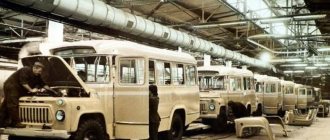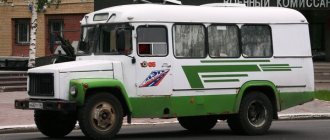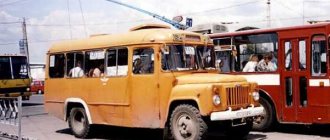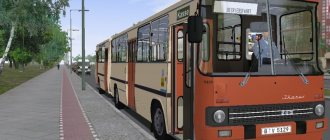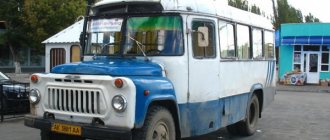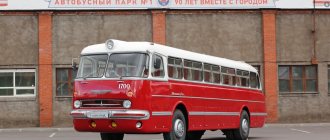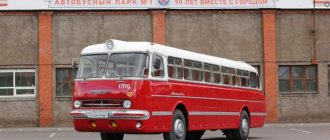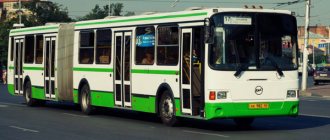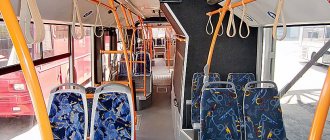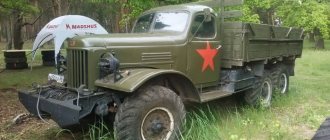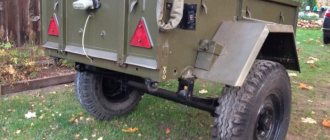Soviet buses produced by the Kurgan Automobile Plant with index 3976 have a fairly long history, which amounts to almost twenty years of experience. The first model debuted in 1989. After that, the manufacturer carried out a number of upgrades. The technical equipment has been improved. Initially, the car was positioned as a small hooded bus, and subsequently there were no changes in this regard. It was intended for making routes both around the city and beyond. The well-known Soviet quality made it possible to operate this machine for many years without special expenses for major repairs.
When compared with modern standards, the KAvZ-3976 bus is significantly inferior to new models. However, this drawback completely covers the cost of the car. Initially, production was made as cheap as possible, which subsequently influenced the formation of sales prices. Model 3976 is currently discontinued. Its production was discontinued in 2007.
KAvZ-39766, all-terrain bus
An all-wheel drive bus is a rare type of equipment, but sometimes such vehicles are simply irreplaceable.
One of the few representatives of the family of all-terrain buses was KAvZ-39766. The hooded bus KAVZ-39766, which began to be produced in Kurgan in 2003, was an “off-road” version of the standard model KAVZ-3976.
Like other bonnets of the plant, KavZ-39766 was based on the chassis of a GAZ truck, but not an ordinary “lawn”, but a GAZ-3308 “Sadko” all-terrain vehicle. The chassis of the bus was the same as that of the truck - all-wheel drive with a plug-in front end, and a reduction gear.
Such KAVZs mainly worked as service buses in areas with bad roads, shift work, and there was also an option for transporting schoolchildren. Inside the car there are from 12 to 20 seats, depending on the version.
KAvZ-39766 was equipped with a gasoline carburetor eight-cylinder engine ZMZ-513.10 with a volume of 4.25 liters (125 hp) and a four-speed gearbox or a four-cylinder diesel engine MMZ-D-245.7 with a volume of 4.75 liters (122 hp) in combination with five-speed gearbox.
The price of a gasoline bus in 2003 was 760 thousand rubles, the diesel version cost from 835 thousand rubles.
Production of the KAvZ-39766 model ended in 2007, at the same time the plant stopped producing all other hooded buses.
Thank you for reading to the end!
Even more interesting reviews about cars are in our Yandex-Zen channel . Also check out our community on VKontakte .
Source
Bus KAVZ 3976
The KAVZ 3976 small bus was produced from 1989 to 2007. During this time, it went through several restylings and design improvements. Initially, the bus was conceived as a cheap form of urban transport. Its production did not require large material and raw material costs, and a high margin of safety made it possible to operate one model for many years without major repairs.
First generation 1989–2004
As mentioned earlier, over 18 years of assembly, some modernization of the KavZ-3976 vehicle was carried out. Its technical characteristics are not very impressive. In order to reduce costs, the manufacturer chose to install, let’s say, not the latest technologies on the bus. However, it cannot be called completely unsuitable for use. He coped with the tasks assigned quite well.
In 1989, the bus was equipped with a domestic ZMZ-513 engine. This model was considered primitive even at that time. It is a simple V-shaped carburetor-type device with 8 valves, which are located at right angles.
The maximum power threshold that this power unit could produce stops at 125 hp. With. The speed limit did not exceed 90 km/h.
Over the years of operation, the engine has proven itself to be reliable under all conditions.
Modernization 2005
The KAVZ-3976 model received a new power unit only 16 years later, in 2005. It was a diesel unit MMZ D-245.7. Its technical characteristics have been slightly improved.
First of all, the manufacturer worked on the aspect of environmental standards; now the engine complies with European standards EURO-2. As for technical nuances, the power indicator decreased by almost 3 units. (122.4 hp.
), high-speed, on the contrary, increased by 5 units, in the new modification the bus could accelerate to 95 km/h.
The chassis was borrowed from the GAZ-33074 model, and not only that. It can be called the progenitor of the KAvZ-3976, since the bus was equipped with the same mechanical transmission, designed for 5 speeds, an engine and other equipment elements. It is worth paying attention to the electrics. It’s problematic to find something new here; everything was also inherited from the GAZ-33074. But with one exception: the new car had interior lighting, which had not been used before.
Specifications
The technical characteristics of the KAVZ 3976 cannot be called outstanding. To reduce the cost of mass production, the development of the bus did not use the most advanced technologies available at that time.
But this did not prevent him from successfully coping with the responsibilities assigned to him. The first KAVZ 3976 models were equipped with a ZMZ-513 engine with a maximum net power of 125 horsepower.
It was a simple and reliable carburetor eight-cylinder engine with a V-shaped arrangement of cylinders at right angles.
The working volume of the power unit was 4.25 cubic centimeters, and the maximum torque was 294 N*m. With such an engine, the bus reached speeds of up to 90 km/h. Since 2005, model 3976 has been equipped with a new MMZ D-245.7 power unit with a capacity of 122.4 horsepower.
This is a four-cylinder in-line diesel engine with a displacement of 4.75 liters. The rotation speed is 2400 rpm and the torque is 422 N*m. The engine complies with international environmental standards EURO-2.
The new power unit allows the bus to accelerate to 95 km/h.
The base model for the KAVZ 3976 was the GAZ 33074 chassis. From its “parent” the bus received a mechanical five-speed gearbox, an engine and many other components and assemblies.
The electrical circuit of the KAVZ 3976 is completely identical to the GAZ one, only it has added interior lighting.
Dimensional parameters of the bus: length - 6.915 meters, width - 2.38 meters, height - 2.38 meters, front track - 1.63 meters, rear track - 1.69 meters, wheelbase - 3.77 meters. Number of seats – 20 (+ driver’s seat).
Total capacity – 28 passengers. For boarding, there was a single front door that opened and closed manually.
This was not the most successful design decision, since the driver very often had to close the door himself, for which a special belt was designed. The closing mechanism often broke and the door stopped closing tightly.
This led to constant flapping when driving and a draft in the cabin. The all-metal body of the carriage layout received anti-corrosion treatment before assembly. The product lifespan was about 6 years.
Transmission
| Автобус местного SЃРѕРѕР±С‰РµРЅРІРљРђРІР—-3976 разработан РљСѓСЂР іР°РЅСЃРєРёРјР°РІС‚обусным заводом РЅР° С€ асси ГАЗ-33074-1010. РљСѓР·РѕРІ замствован РѕС‚ предыдущеймодели РљРђРІР—-3271, выпускавшейся РЅР° шасси ГАЗ-53 -12. Серийное производствоорганоизовано РІ 1989 РіРѕРґСѓ. РљРђРІР—-3976 кмеет капотную RєРѕРјРїРѕРЅРѕРІРєСѓ. Цельнометаллический РєСѓР·РѕРІ SѓСЃС‚анавленна раме РіСЂСѓР·Рѕ РІРІРєР°. Капот Рё оперение SЃРѕСранены РѕС‚ ГАЗ-3307. R' качестве SЃРеловойустановки RїСЂРёРјРµРЅС'РЅ RєР°СЂР±СЋСЂР°С‚РѕСЂРЅ ый 8-С†Релиндровый V-образный двигатель жидкостногоолаждения Р—РњР—-511.10 (позже Р—Р њР—-513.10). Существовали также дизельные RјРѕРґРёС„икациис РґРІРёРіР°С ‚елями ГАЗ-5441, Р”-245. RљРѕСЂРѕР±РєР° передач 5-ступенчатая. Салонрасчитан РЅР° 28 пассажиров (20 сидячиС) + водитель. R”R”SЏ RїRѕSЃR°RґRєRyo RІS‹SЃR°RґRєRyoRїR°SЃSЃR°R¶RyoSЂRѕRІ SЃR»SѓR¶RyoS‚ RѕRґРЅРѕSЃS‚РІРѕСЂС‡ атая распашная дверь РІ передней S‡Р°СЃС‚Рё РєСѓР·РѕРІР°.Место водителя отделено РѕС‚ салона РїРµС ЂРµРіРѕСЂРѕРґРєРѕР№. RR»СЏ водителя имеется отдельнаядверь СЃ левой сторо RSS. Р' задней части РєСѓР·РѕРІР° предусмотрена запасная дверь.Р џРѕРґРІРµСЃРєР° рессорная. RўРѕСЂРјРѕР·РЅР°СЏ SЃРёСЃС‚ема RїРЅРµРІРјРѕРіРёРґСЂР°РІР»РёС‡РµСЃРєР°СЏ. Грузопассажирский вариант РљРђРІР—-3976 применяется РІ аэрРѕРїРѕСЂС‚Р°С РґР»СЏ перевозкиперсонала РЅРµР±РѕР»СЊС €РёС РіСЂСѓР·РѕРІ.
Р'сего было выпущено 450 тысячавтобусов семействР° РљРђРІР—-3976. R' RіРѕСЂРѕРґРµ RЎРµРјС'РЅРѕРІРµ RќРёР¶РµРіРѕСЂРѕРґСЃРєРѕР№ области РЅР° RјРµСЃС‚РЅРѕР јР°РІС‚оремонтном заводе выпускался аналогич ный автобус РЎРђР Р—-3280. RњРѕРґРёС„РекацРеРё R°РІС‚РѕР±СѓСЃР°:
THIS IS INTERESTING: Taxi in Seversk RўРµSRЅРёС‡РµСЃРєРёРµ СѰрктеристики | |
| Р'аза, РјРј | 3770 |
| RљРѕР»РµСЏ, РјРј | 1630/1690 |
| R”орожный просвет, РјРј | 265 |
| R°РґРёСѓСЃ поворота, Рј | 9 |
| RњР°СЃСЃР°, РєРі:РІ SЃРЅР°СЂСЏР¶РµРЅРЅРѕРј SЃРѕСЃС‚ояниполная | 44505870 |
| Число мест для пассажиров:для SЃРёРґРµРЅРёСЏРѕР±С‰РµРµ | 2128 |
| ввигатель:типчисло цилиндроврабочий РѕР±СЉС'Рј, СЃРј2мощРSость, Р.СЃ. | Р—РњР—-511.1084254120 |
| Число передач | 5 |
| RљРѕР»С'сная формула | 4×2 |
| Размер С€РеРЅ | 8,25-20″ |
| Запас топлива, л | 105 |
| RЎРєРѕСЂРѕСЃС‚СЊ максимальная, РєРј/С‡ | 90 |
R›РёС‚ература
- Краткий автомо±РёР»СЊРЅС‹Р№ справочник. РўРѕРј 1. Автобусы. — Рњ.: РќРџРЎРў “ТрансконсаДтинг”, 2002. — РЎ. 191-197.
Suspension
| Front suspension | Dependent, spring |
| Rear suspension | Dependent, spring |
Brakes
| Front brakes | Drums |
| Rear brakes | Drums |
Modifications
KAVZ 397653 is a modification of the basic model, designed for transporting schoolchildren to their places of study. It was equipped with a slightly modified ZMZ-513.10 engine with a maximum power of 90 horsepower. The rotation speed increased to 3400 rpm.
The engine meets the requirements of EURO-1 environmental standards. The bus received a platform extended to 8.47 meters and a second door for boarding passengers.
Special equipment did not allow the vehicle to accelerate to a speed greater than 60 km/h, which was done for the safety of children.
Each seat received its own seat belt and a quick communication button with the driver. The number of seats has increased to 22 units. All traumatic protrusions were removed from the design, and the remaining elements were equipped with soft pads.
Fuel consumption of KAVZ 397653 is 23 liters per 100 kilometers. The bus is painted yellow and has the words “school bus” on the sides. The model had an improved braking system, and also added ABS to help the driver in emergency situations.
The wheel formula of the vehicle is 4x2.
KAVZ 3976-011 is a gas-cylinder modification of the base model. It is equipped with an Italian system for operating on liquefied gas and two refill cylinders of 90 liters each.
KAVZ 3976-020 is a modification for the northern regions of the country. The model received an insulated interior, a powerful heater and an engine pre-heater to start the power unit in any frost.
Repair and maintenance of KAVZ 3976 do not contain problematic issues. The simple design of all components and assemblies allows you to quickly understand the causes of problems and promptly eliminate them. The bus is unpretentious to the quality of oil and fuel and is well adapted for driving on bad roads. Spare parts for KAVZ 3976 can be easily purchased from official dealers of the manufacturer or on the secondary market.
The price of KAVZ 3976 on the secondary market ranges from 50 to 400 thousand rubles. The value depends on the year of manufacture of the model, its mileage and the date of the last major overhaul. Also, old owners could install any additional devices on the vehicle, which will also affect the increase in cost.
THIS IS INTERESTING: Taxi in Kakhovka
Flaws
The first drawback that immediately catches your eye is the presence of only one door. It took a lot of effort to close it. Over time, the mechanism became unusable, so there were always drafts in the cabin that entered through a loosely closed door. When moving, it made rumbling sounds, which, of course, did not increase the level of comfort.
Source: https://spectekhnika.info/kavz-3976/
A little about the layout.
I’ll dwell a little on the layout of the living and working space of the motorhome. Here, by definition, there cannot be a single correct solution, since a lot depends on the subjective perception of such things as comfort, convenience, necessity, and so on. And the second important point is that any decision when planning a motorhome is essentially a compromise, starting from cross-country ability and ending with making a larger shower room or kitchen area. Therefore, I will give some explanations on certain points related to planning and why exactly this way and not otherwise.
First, a short lyrical digression. Most of the decisions were made on the basis of the invaluable experience that was gained in previous travels and which cannot be obtained by reading other people's opinions on the Internet. Some trips were very, very long (the longest was three months on TLC80 without using hotels or tents). Now to the point. Before directly thinking through the interior layout, we tried to formulate as clearly as possible the requirements that our motorhome must meet, identify those things that definitely should be present and, accordingly, which definitely should not be in the motorhome, and set priorities. It is no coincidence that I dwell on this point in such detail, since for many who are just starting to think about any issue, the biggest problem is that they do not have a clear idea of what exactly they want to get in the end. As a result, disappointment with the result obtained. The following was put at the forefront of the entire concept: comfort for us is important only in terms of AVAILABILITY as a fact of vital living conditions, to which we include complete healthy sleep, uncompromising comfort (in terms of maintaining health and the ability to maintain working capacity for a long time) of the driver and navigator(! ) seats, the presence of a shower/toilet, the presence of a backup heating option in case of failure of the main system, the presence of an emergency exit for both the driver and the navigator. Well, now, in fact, I will try to highlight the issues that for many are the most controversial when planning a motorhome. 1. Why didn’t we leave the main door for the navigator, but made it central, losing some space in the cabin? The only reason why the navigator's door was left in place at all is stated above. It is considered exclusively as an emergency option for leaving the car, especially for ice crossings (no matter what anyone says, but I have more than enough examples of people who neglected the rule of driving with an open door on ice, examples of which are deplorable, unfortunately). Having experience driving Korean buses with only a middle door plus a driver's door, I am sure that exiting through the passenger compartment will not cause discomfort. 2. The size of the bathroom is 70x110. Of course, a larger shower room would be more comfortable, but then somewhere the same space will have to be taken away, the question is - where? It was this question that forced us to revise the layout many times, rearranging everything that was possible in the most unimaginable way. As a result, the conclusion was that without sacrificing something vital for us, it simply would not be possible to achieve a better result. And based on the concept described above, a shower only requires its presence, but not the ability to use it comfortably. That is, for us, for example, it is much more important to sleep on a stationary bed that does not require constant folding/unfolding, on a normal orthopedic mattress, and not just a paralon covered with leatherette, than to be able to move freely around the shower room. Again a compromise. 3. About the refrigerator. During global travel, only two people will be in the motorhome at all times. Up to four people only for local use, for example, outings for one or two days and up to six people for a short time, without planned overnight stays within the cabin. We see the need for a refrigerator only during long trips, but for two people we don’t need much, again from experience. When traveling on a Kruzak, by the way, we basically did not have a refrigerator, however, this did not affect the positive impressions of the trip as a whole). 4. About the central door. The second sore point of this car. Yes, we tried for a long time to leave the front door and, if you look at the original layout in the picture below, it was left as is. But! In any option, this inevitably led to the need to move/fold the navigator’s seat, or to make it quite compact and, therefore, not comfortable enough. And in addition to this, it excluded the possibility of a smooth transition for the driver to the bus interior.
KAVZ 3976 Family Motorhome ⇐ Other models
Post by Andrey_irk » 21 Dec 2022, 08:59
Post by POL » 21 Dec 2022, 11:07
Post by ABR-auto » 22 Dec 2022, 07:48
Post by Andrey_irk » 16 Jan 2022, 09:19
Friends, I’ll write what’s been done about the bus: On the one hand, it’s good when the bus is at the enterprise, it seems like they don’t save money, they carry out maintenance, but the owner of the car doesn’t exist, and this leads to consequences. 1 Consequence of traveling on water, the radiator was completely rotten, I took it in for repairs and they said it was beyond repair. I bought it for 1000 rubles. radiator with two fans from a Subaru Impreza mechanic. The area is slightly larger and the thickness is slightly smaller. Let's see how the engine temperature will be. I immediately wanted to convert the constantly rotating fan to electric. I want to install two temperature sensors (8-) one turns on early and the other turns on later, so that if suddenly there is a reserve on the fan on the road. I turned off the second stove for now (series 020 - northern version) otherwise you won’t have enough antifreeze, as soon as I check the whole system, maybe I’ll power up the second stove. 2 The consequence is a shitty 80 petrol and a dirty carburetor. I cut off the resin stalactites with a knife. Later I bought a repair kit and will replace it. 3 Replaced all the optics, headlights, turn signals.
What else. As a result, the bus will be category M1 (for transporting people), but you can drive it with a category “C” license. Today we agreed with the person on the documents for re-registration into a turnkey “Auto-home”, all that remains is to agree on the list of changes, we will meet. The price tag (33,000 rubles) is normal, I think.
I’m slowly thinking about what to do with the gearbox, most likely it will be a Japanese manual transmission, in the future, if I don’t like it, I’ll install an automatic transmission from a truck, there are those too, and even some sell them cheaper than manual transmissions. The interior found 3 rows of seats from HONDA Elysion, which are very comfortable while driving, but you need to think about how to transform it into a bed.
I wrote to Dmitry from the Moscow region, he travels in a motorhome 6 out of 12 months of the year, we had a very close correspondence, and gave a lot of useful advice. I’ll try to sort everything out in some kind of message.
That's all for now, let's do it slowly. I work out in the evenings and on weekends when it’s warm. Good luck to all!!
Source
Dimensions
At the time of the release of model 3976, all Soviet buses were almost identical. This similarity was visible not only in technical equipment, but also in appearance. The dimensions of this car cannot be called large, but they are quite sufficient for transporting employees of institutions, as well as for use as urban transport (until 2000). Currently, these machines remain only on the balance sheet of some state enterprises.
So, let's move on to the dimensions. The length of the body reaches almost 7 m, or to be more precise, 6915 mm. The width is not very large - 2380 mm, height - 3030 mm. Bus 3976 could travel unhindered on country roads thanks to its considerable ground clearance of 265 mm. There are 21 seats in the cabin, but the total capacity is 28.
Detailed description, device
The body is all-metal on a steel frame with steel sheet covering. In recent years, it has been additionally treated with an anti-corrosion compound . The interior equipment could be utilitarian with leatherette seats or trimmed with velor and artificial leather. The suspension of all wheels is spring . The braking system is pneumohydraulic.
In 1989, the bus was equipped with a domestic ZMZ-513 - a simple V-shaped carburetor-type device with 8 valves, which are located at right angles. The maximum power threshold stops at 125 hp. With. The speed limit is 90 km/h. Over the years of operation, the engine has proven itself to be reliable under all conditions.
Bus KAvZ-3976. Photo Wikipedia
The KAVZ-3976 model received a new power unit in 2005 . It was a diesel unit MMZ D-245.7. Its technical characteristics have been slightly improved. First of all, the manufacturer worked on the aspect of environmental standards; now the engine complies with European standards EURO-2 . As for technical nuances, the power indicator decreased by almost 3 units. (122.4 hp), high-speed, on the contrary, increased by 5 units, in the new modification the bus could accelerate to 95 km/h .
The chassis was borrowed from the GAZ-33074 , and not only that. It can be called the progenitor of the KAvZ-3976, since the bus was equipped with the same mechanical transmission, designed for 5 speeds, an engine and other equipment elements. It is worth paying attention to the electrics. It’s problematic to find something new here; everything was also inherited from the GAZ-33074. But with one exception: the new bus had interior lighting, which had not been used before.
Technical characteristics of the new bus
First of all, the updated GAZ 53-12 1040 chassis, which was already mentioned earlier. Its production at the Gorky Automobile Plant began in 1983 and was characterized mainly by an increase in payload capacity and engine replacement.
Chassis tonnage increased from 4 to 4.5 tons. As for the engine, the old carburetor 115-horsepower ZMZ 53A was replaced by a 120-horsepower carburetor ZMZ 53-11, with eight V-shaped cylinders, a volume of 4.25 liters and a higher compression ratio of the cylinder heads: 7.6 versus 6 ,7. The new engine also had a different lubrication system: a 1-section oil pump and a full-flow oil filter, and the ZMZ 53-11 engine crankcase received a closed ventilation system. Thanks to these changes, the power of the KAVZ 3270 bus increased by 5 hp and specific fuel consumption fell by 7%, which ultimately amounted to 19 liters per 100 km. at an average operating speed of 60 km/h. versus 24 liters per 100 km. on the 685 M model. In addition, the emission of harmful substances into the atmosphere has dropped by as much as 20%. The volume of the fuel tank also increased; brand 3270 buses were equipped with a tank from a GAZ 66 with a capacity of 105 liters.
However, the transformations did not end there. The steering column of the KAVZ 3270 bus was replaced, and the brake system of the model was also significantly changed. It became double-circuit and was equipped with a hydraulic drive and a vacuum-type amplifier. The brakes themselves were drum brakes, and the parking brake was mechanical from the gearbox.
Other changes include an updated transmission. KAvZ 3270 had a mechanical four-speed GAZ 53-12 gearbox with a single hypoid main gear (GP gear ratio - 6.17) and a single-plate clutch with hydraulic drive and peripheral springs. The maximum speed of the bus has increased to 90 km/h.
Electrical equipment on the bus became 12 volt. The chassis frame was strengthened, and the spring semi-elliptic leaf suspension (both front and rear), on the contrary, became softer due to the installation of additional springs and telescopic shock absorbers on the rear axle.
The length of the wheelbase of the updated chassis was 3.7 meters with a 1.63 meter front track and 1.97 meter rear track. The wheels on the chassis were 20 inch, with 8.25 R20 tires. The ground clearance was 46 cm, which allowed the bus to overcome inclines of 26%.
The chassis from the Gorky plant was sent to the Kurgan plant completely ready for work, but without a cabin, but only with a frame for the windshield. Here they installed a cabin on it and checked the operation of the main components. After installing the cabin, the working dimensions of the KAVZ 3270 bus were (LxWxH, m): 6.5x2.55x3.03 with 21 seats and a nominal capacity of 30 people. The bus was equipped with a single-leaf door with manual opening/closing.
Specifications
The technical characteristics of the KAVZ 3976 cannot be called outstanding. To reduce the cost of mass production, the development of the bus did not use the most advanced technologies available at that time. But this did not prevent him from successfully coping with the responsibilities assigned to him. The first KAVZ 3976 models were equipped with a ZMZ-513 engine with a maximum net power of 125 horsepower. It was a simple and reliable carburetor eight-cylinder engine with a V-shaped arrangement of cylinders at right angles.
The working volume of the power unit was 4.25 cubic centimeters, and the maximum torque was 294 N*m. With such an engine, the bus reached speeds of up to 90 km/h. Since 2005, model 3976 has been equipped with a new MMZ D-245.7 power unit with a capacity of 122.4 horsepower. This is a four-cylinder in-line diesel engine with a displacement of 4.75 liters. The rotation speed is 2400 rpm and the torque is 422 N*m. The engine complies with international environmental standards EURO-2. The new power unit allows the bus to accelerate to 95 km/h.
The base model for the KAVZ 3976 was the GAZ 33074 chassis. From its “parent” the bus received a mechanical five-speed gearbox, an engine and many other components and assemblies. The electrical circuit of the KAVZ 3976 is completely identical to the GAZ one, only it has added interior lighting. Dimensional parameters of the bus: length - 6.915 meters, width - 2.38 meters, height - 2.38 meters, front track - 1.63 meters, rear track - 1.69 meters, wheelbase - 3.77 meters. Number of seats – 20 (+ driver’s seat).
Total capacity – 28 passengers. For boarding, there was a single front door that opened and closed manually. This was not the most successful design decision, since the driver very often had to close the door himself, for which a special belt was designed. The closing mechanism often broke and the door stopped closing tightly. This led to constant flapping when driving and a draft in the cabin. The all-metal body of the carriage layout received anti-corrosion treatment before assembly. The product lifespan was about 6 years.
Transmission
Suspension
Brakes
Bus technical characteristics
The technical characteristics of the KAvZ 685 met the requirements of its time. The first bus models were equipped with four-stroke eight-cylinder carburetor engines ZMZ-53A. The cylinders were arranged in a V-shape. The power unit had a power of 120 horsepower at a rotation speed of 3200 rpm. The torque was 245 N*m at a speed of 2000-2500 rpm. The working volume is 4254 cubic centimeters. The bus consumed 24 liters of fuel per 100 kilometers. The capacity of the fuel tank was 105 liters. The maximum speed was 90 km/h. The vehicle was equipped with a four-speed manual gearbox. It was a slightly modified GAZ-53-12 model, which received synchronizers for third and fourth gears.
The KAvZ 685 used a dry-type single-plate clutch with peripheral spring mechanisms. The switching was carried out using a hydraulic drive. The brake system had two circuits and drum mechanisms acting on all wheels. A hydraulic drive equipped with a vacuum booster was responsible for switching on. The tires used were 8.25R20 tires with a universal tread pattern.
Overall dimensions of the KAVZ 685 bus: length - 6.6 meters, width - 2.55 meters, height - 3.03 meters, wheelbase - 3.7 meters, ground clearance - 265 millimeters, front track - 1.63 meters, rear track - 1.97 meters. The curb weight of the vehicle was 4.08 tons, and the gross weight was 6.545 tons. Axle load distribution: front - 2,225 tons, rear - 4,320 tons. Wheel formula - 4x2. The minimum turning radius was 9 meters.
KAvZ 685 had 21 seats and a total of 28 passengers. There was only one side door for boarding. There was also an emergency exit through the rear emergency door. The salon received a good heating system, which made it possible to warm up the interior well in cold weather. Ventilation was carried out naturally using opening side windows and hatches. For the comfort of passengers, soft seats were installed, trimmed with thick fabric, which was highly resistant to wear and could last several seasons before being replaced. The driver's compartment was not separated from the passenger compartment, which was acceptable according to old safety standards. The driver had his own door for boarding.
The bus had an all-metal bonnet-type body. The presence of a hood significantly simplified access to all components and systems of the engine, which made it easy to carry out service and repairs. Repairing the KAvZ 685 did not cause much trouble. The bus was built on the GAZ-53A chassis, which passed numerous tests and was well prepared for off-road use. A high degree of unification made it possible to obtain the necessary parts without any problems. Many years of experience working with basic elements of the chassis and power unit allowed mechanics to quickly find the cause of the malfunction and promptly fix it.
The driver’s workplace had sufficiently comfortable conditions so that a person would not get too tired during regular flights. The seat was adjustable in terms of distance from the dashboard and the angle of the backrest. The steering mechanism did not have a hydraulic booster, but the steering wheel had a large diameter, which made driving the bus somewhat easier. All controls were at hand and easy to access
Of the control instruments, there was only the most necessary, so as not to dissipate attention to secondary indicators. The rear-view mirrors were large and protruded significantly beyond the dimensions of the vehicle to improve visibility.
The windshield was divided into two sectors by a central partition. Each half had one windshield wiper. This design did not interfere with normal control of the road situation.
Basic information, characteristics
Manufacturer/manufacturer where the equipment is produced/manufactured. Kurgan Bus Plant named after the 60th anniversary of the USSR (KAvZ)). Currently, KavZ LLC is a subsidiary of GAZ OJSC.
Purpose. Depends on the modification. The basic modification is intended for local traffic, i.e. intra-district, rural vehicles.
Class. Average.
Body type. Bonnet.
Modifications
KAvZ-3976-53 was mainly used for transporting children. It differed in length: in this modification the platform was increased to 8470 mm. The presence of a second door became its main advantage. Since the main task of the bus is to transport children, special equipment was installed at the plant, which was responsible for the speed of movement. It did not allow the driver to accelerate the vehicle over 60 km/h. The installation of a modern ABS system has significantly increased the level of car safety.
KAvZ-3976-011 is a gas-powered model. It was developed to reduce fuel costs. The production of the gas installation was carried out by an Italian company. Thanks to this modernization, the bus could travel long distances without additional refueling. This opportunity appeared after installing a kit consisting of 2 cylinders of 180 liters each.
KAvZ 3976-020 has improved interior characteristics. It used high-quality insulation, which made it possible to operate the bus in areas with low air temperatures. Modern heating systems were installed on these models.
Engine/powertrain characteristics
Type. Gasoline, later diesel.
Number and arrangement of cylinders. 8 cylinders, V-shaped at an angle of 90 degrees.
Environmental safety standards. It differs depending on the modification; the base version is EURO-2.
Working volume, l. 4250.
Engine power, kW (hp)/min. 125.
Maximum torque, Nm/min. 294.
Engine location. Anterior, longitudinal.
Checkpoint. Mechanical, 5 gears.
Control fuel consumption at 60 km/h, l/100 km. 22,8.
Maximum speed, km/h. Varies depending on the modification, for the basic one – 90.
Pre-heating. No.
Technical points 1989–2004
As mentioned earlier, over 18 years of assembly, some modernization of the KavZ-3976 vehicle was carried out. Its technical characteristics are not very impressive. In order to reduce costs, the manufacturer chose to install, let’s say, not the latest technologies on the bus. However, it cannot be called completely unsuitable for use. He coped with the tasks assigned quite well.
In 1989, the bus was equipped with a domestic ZMZ-513 engine. This model was considered primitive even at that time. It is a simple V-shaped carburetor-type device with 8 valves, which are located at right angles. The maximum power threshold that this power unit could produce stops at 125 hp. With. The speed limit did not exceed 90 km/h. Over the years of operation, the engine has proven itself to be reliable under all conditions.
The bus is used on suburban and intercity routes
Externally, the bus is similar to a European-made passenger transport. Wide tinted side windows give passengers a good view, a comfortable interior with comfortable seats meets international standards, and hinged rear-view mirrors optimally inform the driver about the traffic situation behind the vehicle. The bus has luggage compartments of increased capacity, which allows it to be used for intercity transportation.
The basic model KAVZ 4238 has several modifications. KAVZ 4238-01 is designed for commuter flights. It has increased seating capacity to 39 people and firmer seats than intercity models. Otherwise, its parameters correspond to the characteristics indicated above.
KAVZ 4238-02 is used for intercity traffic. The bus has 35 seats and an enlarged luggage compartment. It also features softer seats that have increased width to improve passenger comfort during long journeys.
KAVZ 4238-04 is used as urban public transport. It has a different interior layout to increase spaciousness. The number of seats has been reduced to 21, while the total number of passengers transported at a time has reached 82 people. The luggage compartments were removed as there was no need, which made it possible to expand the interior a little more. The rear door has become almost twice as wide (1400 millimeters). The total weight of the bus increased to 13.7 tons.
KAVZ 4238-05 acts as a school bus for delivering children to their place of study. The bus has 32 seats, and each seat is equipped with a seat belt. There is also an emergency communication device for the driver at each seat, and the driver has a loudspeaker for communication with the cabin. The bus has an additional step so that elementary school students can get inside without assistance. The engine is equipped with an electronic locking system that prevents movement when the doors are open, and also limits the maximum speed to 60 km/h.
KAVZ-4238 buses have good service and repair parameters. The engine has convenient access directly from the cabin, so it can be repaired in any bad weather. The parts are designed for daily intensive use and have a large margin of safety. Spare parts for KAVZ 4238 can be easily purchased from official dealers. They are always in stock, so you won’t have to wait long for the required item.
Reviews about KAVZ 4238 are purely positive. The bus is praised for its high performance, economical fuel consumption, high level of active and passive safety, and comfortable interior. Maintenance personnel note the simplicity and convenience of access to all necessary systems.
Prices for KAVZ 4238 depend on the functional equipment. Official dealers of the manufacturer put out offers for products in the region of 3.8-4 million rubles. On the secondary market you can purchase equipment at half the price. But purchasing a used vehicle always involves the risk of getting a low-quality product, so before concluding a deal it is worth conducting a comprehensive diagnosis of the selected model.
Kavz 3976 - local bus
The KAVZ 3976 small bus was produced from 1989 to 2007. During this time, it went through several restylings and design improvements. Initially, the bus was conceived as a cheap form of urban transport. Its production did not require large material and raw material costs, and a high margin of safety made it possible to operate one model for many years without major repairs.
Bus technical characteristics
The technical characteristics of the KAVZ 3976 cannot be called outstanding. To reduce the cost of mass production, the development of the bus did not use the most advanced technologies available at that time.
But this did not prevent him from successfully coping with the responsibilities assigned to him. The first KAVZ 3976 models were equipped with a ZMZ-513 engine with a maximum net power of 125 horsepower.
It was a simple and reliable carburetor eight-cylinder engine with a V-shaped arrangement of cylinders at right angles.
The working volume of the power unit was 4.25 cubic centimeters, and the maximum torque was 294 N*m. With such an engine, the bus reached speeds of up to 90 km/h. Since 2005, model 3976 has been equipped with a new MMZ D-245.7 power unit with a capacity of 122.4 horsepower.
This is a four-cylinder in-line diesel engine with a displacement of 4.75 liters. The rotation speed is 2400 rpm and the torque is 422 N*m. The engine complies with international environmental standards EURO-2.
The new power unit allows the bus to accelerate to 95 km/h.
The base model for the KAVZ 3976 was the GAZ 33074 chassis. From its “parent” the bus received a mechanical five-speed gearbox, an engine and many other components and assemblies.
The electrical circuit of the KAVZ 3976 is completely identical to the GAZ one, only it has added interior lighting.
Dimensional parameters of the bus: length - 6.915 meters, width - 2.38 meters, height - 2.38 meters, front track - 1.63 meters, rear track - 1.69 meters, wheelbase - 3.77 meters. Number of seats - 20 (+ driver's seat).
Total capacity - 28 passengers. For boarding, there was a single front door that opened and closed manually.
This was not the most successful design decision, since the driver very often had to close the door himself, for which a special belt was designed. The closing mechanism often broke and the door stopped closing tightly.
This led to constant flapping when driving and a draft in the cabin. The all-metal body of the carriage layout received anti-corrosion treatment before assembly. The product lifespan was about 6 years.
Overview of main modifications
KAVZ 397653 is a modification of the basic model, designed for transporting schoolchildren to their places of study. It was equipped with a slightly modified ZMZ-513.10 engine with a maximum power of 90 horsepower. The rotation speed increased to 3400 rpm.
The engine meets the requirements of EURO-1 environmental standards. The bus received a platform extended to 8.47 meters and a second door for boarding passengers.
Special equipment did not allow the vehicle to accelerate to a speed greater than 60 km/h, which was done for the safety of children.
Each seat received its own seat belt and a quick communication button with the driver. The number of seats has increased to 22 units. All traumatic protrusions were removed from the design, and the remaining elements were equipped with soft pads.
Fuel consumption of KAVZ 397653 is 23 liters per 100 kilometers. The bus is painted yellow and has the words “school bus” on the sides. The model had an improved braking system, and also added ABS to help the driver in emergency situations.
The wheel formula of the vehicle is 4x2.
KAVZ 3976-011 is a gas-cylinder modification of the base model. It is equipped with an Italian system for operating on liquefied gas and two refill cylinders of 90 liters each.
KAVZ 3976-020 is a modification for the northern regions of the country. The model received an insulated interior, a powerful heater and an engine pre-heater to start the power unit in any frost.
Repair and maintenance of KAVZ 3976 do not contain problematic issues. The simple design of all components and assemblies allows you to quickly understand the causes of problems and promptly eliminate them. The bus is unpretentious to the quality of oil and fuel and is well adapted for driving on bad roads. Spare parts for KAVZ 3976 can be easily purchased from official dealers of the manufacturer or on the secondary market.
The price of KAVZ 3976 on the secondary market ranges from 50 to 400 thousand rubles. The value depends on the year of manufacture of the model, its mileage and the date of the last major overhaul. Also, old owners could install any additional devices on the vehicle, which will also affect the increase in cost.
Photo of the bus
Source: https://promplace.ru/passenger-transport-staty-i-obzory/avtobus-kavz-695-3976-1363.htm
General characteristics
Below are standard transport sizes:
- Length - 6.59 meters;
- Width – 2.49 meters;
- Height – 3 meters;
- The clearance between the road surface and the axle is 1.6 meters;
- Bus weight 4 tons;
- Loaded 6.45 tons;
- Load spread: front axle 2.3 tons, rear axle 4.3 tons;
- Turning radius 8.9 meters.
The KAVZ 685 bus can accommodate 28 passengers. Moreover, one door was intended for boarding and disembarking. At the stern there was also a door and an exit in case of an emergency. The well-heated cabin received numerous good reviews from passengers.
By the way, ventilation was regulated by opening and closing windows. It was quite convenient.
The car body is all-metal. The presence of a hood made repair work easier for the driver. If necessary, the engine could be repaired without any problems. The bus chassis was installed from the “lawn” 53A. It was quite suitable for driving over rough terrain.
The presence of a large number of standard spare parts on the market eliminated repair issues. The engine of the car could be put in order even in the field.
Driver's seat
As for the driver's seat, it was well equipped. The seat could be fixed in different positions. There was no hydraulic control boost. However, this was more than compensated for by the presence of large wheels, which made driving the vehicle easier.
All control devices are located compactly in one place. They are simple and understandable even for a beginner. The rear view mirrors are large and provide good visibility. The windshield is divided by a bulkhead. And most importantly, there is a separate snowblower on each half.
Source
KaVZ 685: technical characteristics of the bus
KAVZ 685 buses were successful cars. They were produced for twenty years (1971-1991) in the city of Kurgan and were very popular. These vehicles belong to the small class, as they are designed for general purpose.
Advantages
It was assumed that the bus would be used in rural areas where there are many unpaved surfaces. Because of this reason, additional details were initially included in the designed model for a high level of cross-country ability. As for the chassis, it was made with an excessive margin of safety.
For its time, the KAVZ 685 bus was an advanced vehicle that had good technical characteristics and was on par with the best examples:
- Four-stroke carburetor power plant (3M3-53A).
- V-shaped layout
- Eight-cylinder engine capable of developing 122 hp.
- RPM 3220.
- Engine capacity is 4255 cubic centimeters.
Fuel consumption is approximately 24 liters per 100 kilometers. Moreover, the car could move at speeds of up to 90 kilometers per hour. The gearbox was a four-speed manual. The tank held about 110 liters of fuel. Essentially, the bus was an improved GAZ model with serial number 53-12. This model had synchronizers for 3rd and 4th gear.
The clutch had a single disc and was engaged using a hydraulic drive. The brake system had two circuits. There were also drum elements that connected both wheels.
There was also a hydraulic drive, which included an effective vacuum booster. The most versatile tires were installed, tread 8.20 R20.
General characteristics
Below are standard transport sizes:
- Length - 6.59 meters;
- Width – 2.49 meters;
- Height – 3 meters;
- The clearance between the road surface and the axle is 1.6 meters;
- Bus weight 4 tons;
- Loaded 6.45 tons;
- Load spread: front axle 2.3 tons, rear axle 4.3 tons;
- Turning radius 8.9 meters.
The KAVZ 685 bus can accommodate 28 passengers. Moreover, one door was intended for boarding and disembarking. At the stern there was also a door and an exit in case of an emergency. The well-heated cabin received numerous good reviews from passengers.
By the way, ventilation was regulated by opening and closing windows. It was quite convenient.
The car body is all-metal. The presence of a hood made repair work easier for the driver. If necessary, the engine could be repaired without any problems. The bus chassis was installed from the “lawn” 53A. It was quite suitable for driving over rough terrain.
The presence of a large number of standard spare parts on the market eliminated repair issues. The engine of the car could be put in order even in the field.
Driver's seat
As for the driver's seat, it was well equipped. The seat could be fixed in different positions. There was no hydraulic control boost. However, this was more than compensated for by the presence of large wheels, which made driving the vehicle easier.
All control devices are located compactly in one place. They are simple and understandable even for a beginner. The rear view mirrors are large and provide good visibility. The windshield is divided by a bulkhead. And most importantly, there is a separate snowblower on each half.
Price
KAVZ 685M and other models cost from 180,000 to 529,000 rubles. Although there are variations that cost more than one million. The condition of such mechanisms is very good. They can serve faithfully for a long time.
Exterior photo
The KAVZ 685 bus served well. He can be seen in numerous Soviet films of the 70-80s, in this sense he will remain forever in memory. The simplicity and reliability of the machine were generally recognized among the people. The technology was a real “workhorse” that helped many hundreds of thousands of people in their work.
THIS IS INTERESTING: Taxi in Thailand
Source: https://naperevoz.ru/transport/avtobusy/kavz-685.html
